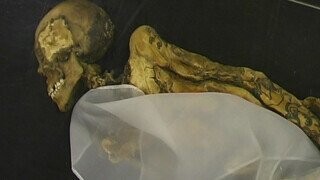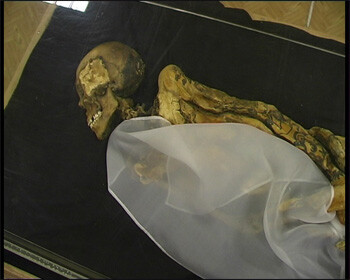12 Bizarre Ways People Got Turned Into Mummies

Everybody loves mummies. They're just really cool. Not only are they fascinating glimpses into ancient cultures as well into the concept of death, but they're also invaluable as sources of information about the people who came before us; and how those people have influenced who we are today. While the word "mummy" probably conjures up an image of a body wrapped in bandages like Egyptian mummies, mummies can happen in all kinds of ways -- intentionally or not. Here are some ways in which humans have become mummies ...
In Honey
Honey has long been known to have preservative properties and has long been used to store food. It's also been long used as a treatment for a variety of ailments like burns and ulcers. And with the combination of healing and preserving comes using it to preserve people. Mummification in honey has been practiced in various places in the world, including the Middle East, Eastern Europe, and Southeast Asia. There's even a legend about people snacking on some ancient honey and pulling out the preserved body of a child, though it's unclear if this ever really happened.
Don't Miss
16th-century Chinese apothecary Li Shizhen tells of holy men in Arabia who would voluntarily eat nothing but honey until they died, then have their bodies submerged in honey to make a mellified man a sort of human-honey substance believed to be a panacea. While bodies preserved in honey have certainly been found, the mellified man remains a legend.

In The Arctic
In 1846, 20-year-old John Torrington was a crew member of the HMS Terror, one of two ships in the ill-fated Franklin Expedition to find the legendary Northwest Passage through the Arctic. About seven months into the voyage, John fell ill and died, and his body, along with those of William Braine and John Hartnell, were buried on Beechey Island in Nunavut, the first casualties of a doomed voyage.
Their graves wouldn't be rediscovered until 1976. The bodies were remarkably well-preserved thanks to the climate and offered scientists a look into how lead poisoning, tuberculosis, and malnutrition added to the demise of the Franklin Expedition.
As A Forgery
In 2000, archaeologists stumbled upon what they thought was an ancient Persian mummy from around 600 BCE and rescued it from the black market. It was an exciting find because the Egyptian-style mummification had never been seen outside of Egypt, and scholars hoped they had made a big discovery in Persian history. But they were wrong. On closer inspection, the very real body in the sarcophagus turned out to be not Rhodugune, daughter of Xerxes I, but a woman who had died, possibly by homicide, in 1996.

It's never been discovered who did the grisly deed of mummifying this woman, and the true identity of the "Persian Princess" remains unknown.
In A Statue
In the 1990s, a beautifully carved and gilded Buddha statue, which belonged to a private collector, underwent restorations, and, as part of the standard procedure, got some x-rays. And that was when the bones were found. Inside the statue, which dated to the 1200s, was the body of a man in the lotus position who was about 200 years older than the statue. It's believed that this monk, whose name was Liuquan, underwent the self-mummification process (see #8), and his remains were eventually placed inside the statue 200 years later, possibly to help preserve them.
The original collector of the statue never had any idea there were human remains inside. The statue, and the monk inside, are now touring museums.
While Still Alive
Sokushinbutsu is the practice of mummifying the body while still alive and was practiced throughout a number of Buddhist lands and in several Buddhist traditions. The oldest self-mummified monk found dates back from the mid-14th century, but records of the practice in ascetic Buddhist tradition go back much further. To date, about 24 have been found, but it's possible there are hundreds more out there.

To achieve sokushinbutsu, monks would follow a strict starvation diet made up of pine needles and resins to eliminate fat and stop drinking liquids to dehydrate themselves until they died, all while chanting mantras. The practice was outlawed in Japan in 1879.
In Salt
In 1994 a group of naturally mummified men were discovered in the Chehrabad Salt Mine in Iran's Zanjan Province. They came from different time periods, ranging from 9550 BCE to the 200s BCE. Iron knives, a leather boot, textiles, tools, and a gold earring were also found. More "saltmen" were found in 2005 and 2007, bringing the total to six.
The mines have been used since ancient times, and it's believed these men all died in mining accidents. The most famous one, whose head is on display in the National Museum of Iran, died 1,700 years ago between the ages of 35 and 40. The salt preserved his body and gave his remaining hair a distinct white color.

Reinforced With Sticks And Clay
The Chinchorro civilization lived in the extremely arid Atacama Desert in what is now Chile and seems to have been practicing mummification some 2,000 years before the Egyptians, with the oldest Chinchorro mummy dating from 5050 BCE. Natural mummies from the region are even older.
To create the mummies, soft tissues and skin were removed from the body, and the bones were reinforced with sticks. The body was then filled with woven mats, and the body reassembled before being coated in clay and left to dry for about a month.

Over the centuries, different techniques were used, and facial features were added to the clay to recreate the deceased's likeness. Some of the mummies have been so well preserved that tattoos have been noted.
In A Bog
Bog bodies have been found all over Northern Europe, and some 1,850 bog bodies have been found, though only about 45 remain fully intact today. The oldest is dated to 8000 BCE. The anaerobic and acidic properties of the bogs preserved their skin and hair incredibly, with fingerprints, eyelashes, and even stubble remaining clearly visible and intact.

Hairstyles, including one man with pine resin "hair gel," as well as clothing, have also been recovered. They are so well-preserved that initially, people thought they had stumbled across modern murder victims. Sometimes, while the skin and hair remain, the bones do not, resulting in a "skin bag" effect, but others retain their bones and have even had their faces forensically reconstructed.

via Wiki Commons
While some may be accidental deaths, many of these bodies show evidence of violent and possibly ritual deaths, suggesting that at least some may have been human sacrifices, though the exact circumstances of these sacrifices remain mysterious. (And besides preserving humans, bogs have also been known to preserve ancient butter.)
On A Mountain
In about 1500, three Inca children, heavily drugged on coca and alcohol, were buried in a tomb high in the Andes and left to die as ritual sacrifices. These children, a 15-year-old girl and a younger boy and girl about four or five years old, were found nearly perfectly preserved; even today, they appear to be sleeping. The incredible preservation of the children, who came from noble backgrounds, allowed for insight into food, clothing, and society of the times.

"Yes, that they MURDER CHILDREN."
The eldest girl's hair was elaborately braided, and the other children were wrapped in intricately woven blankets. The younger girl's body had, at one time, been struck by lightning, earning her the nickname "la nina del rayo," or "Lightning Girl." Child sacrifice was not uncommon in the Inca Empire, and others have been found on other mountains. Known as the Children of Llullaillaco, their display in museums has caused controversy regarding indigenous rights and spurred debates over the appropriateness of putting human remains on display.
Full Of Mystery Liquid
When Lady Xin Zhui, also known as Lady Dai, died in 168 BCE at the age of 50, in what is now China's Hunan Province, she was given a lavish burial that reflected her equally lavish lifestyle. She was wrapped in 20 layers of clothing, interred in four nesting coffins, and buried in an elaborate tomb full of offerings, including a massive feast. But most striking was her body.

Preserved in a mysterious, mildly acidic liquid, her skin was still soft and her joints still flexible. She had Type A blood, her fingerprints were still distinct, and even her eyelashes were intact.
Her body was in such immaculate condition that a full autopsy could be done, and archaeologists learned all about her health issues (many), her cause of death (heart failure), and her last meal (melons). The exact composition of the fluid she was preserved in has never been ascertained.
With Tattoos
In 1993, the remains of a Pazyryk woman were found in an elaborate tomb on the Altai Steppe in Siberia, near the China border. The woman, who died at about 25, was evidently an extremely important person, as she was buried with six horses, finely crafted clothing and grave goods, food and drink, cannabis, and one very tall hat. Her skin had also been preserved well enough by the permafrost to show elaborate tattoos branching across both arms, across her back, and up one shin.

The tattoos show prancing antelope-like animals with flowers blooming from their horns. One theory is that the tattoos were symbols of her status and experience, as other, younger female mummies found in the area had tattoos covering less of their bodies. In response to tensions between the native Altaians and the Russian government, the "Ice Princess" has become a symbol of Altaian identity.
In A Skirmish (Maybe)
The Iceman is one of the most famous natural mummies. Found in the Alps on the border of Italy and Austria, this mummy dates from 3400 BCE. He was found with a complete outfit and gear designed for walks across the Alps, including leather and bearskin clothing and wide, snowshoe-like shoes. He also carried a knife, an ax, and arrows.

Some historians believe that instead of hunting, he may have been involved in a conflict, as he died from an arrow wound that caused him to bleed out, a fatal wound even with today's medical advancements. His natural preservation in the ice allowed scientists to learn a lot about Copper Age Europeans' clothing, diet, and technology. He also had a number of tattoos. At first, seemingly a random collection of lines, some theorize these may have actually been therapeutic in nature as a form of proto-acupuncture.